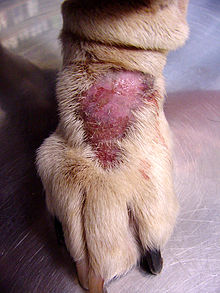
Allergies*
Atopy* is an allergy to a substance with which the dog is not necessarily in direct contact. It is a type I hypersensitivity to a substance that is inhaled or absorbed through the skin. Up to 10 percent of dogs are affected.[77] It is common in dogs, especially seen in breeds such as Labrador Retrievers, Golden Retrievers, and Shih Tzus. The most common symptom is itching. Affected areas include the underside, the face, the feet, and the ears.[78]
Flea allergy dermatitis is the most common skin disease of dogs in the United States. It is caused by sensitivity to flea saliva.[79]
Food allergy* in dogs is commonly manifested as itching, especially of the face, paws, and the underside. Skin testing has proved unreliable, and a trial of a hypoallergenic diet is usually used for diagnosis.[80]
Follicular dysplasia is a genetic disease of dogs causing alopecia, or hair loss. It is caused by hair follicles that are misfunctioning due to structural abnormality.[34]
Dermoid sinus a genetic, autosomal skin condition in dogs. It can appear as single or multiple lumps on the dorsal midline.[34]

Lick granuloma from excessive licking
Lick granuloma also known as acral lick dermatitis, is a skin disorder in dogs resulting from an urge to lick the lower portion of the leg. The lesion from the incessant licking is a thickened, firm, oval plaque.[34]
Pemphigus is an uncommon autoimmune skin disease. The most common form in dogs is pemphigus foliaceus, which manifests as erosions and crusting of the skin and mucocutaneous junctions. Pemphigus vulgaris is more rare and manifests as blister-like lesions in the mouth and at mucocutaneous junctions. Bullous pemphigoid is most commonly seen in Dobermanns and Collies and appears as a scald-like lesion of the groin.[81]
Sebaceous adenitis is an uncommon autoimmune skin disease. Most commonly found in Akitas and Standard Poodles.[82]
Dermal fragility syndrome, also known as Ehlers–Danlos-like syndrome, is a rare condition in dogs characterized by increased skin elasticity and poor wound healing. There appears to be a genetic basis for the disease.[83]
Discoid lupus erythematosus is an uncommon autoimmune disease of the skin in dogs. It does not progress to systemic lupus erythematosus in dogs. The most common initial symptom is scaling and loss of pigment on the nose.[34]
Juvenile cellulitis, also known as puppy strangles, is a disease that affects puppies. Its cause is unknown, but it is likely to have a hereditary component related to the immune system
Comments